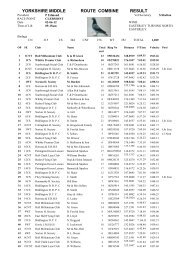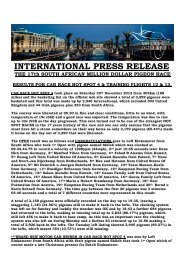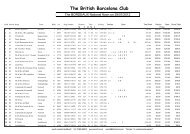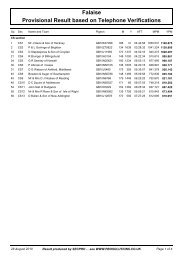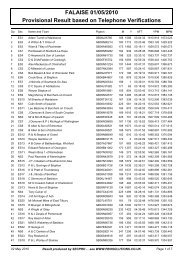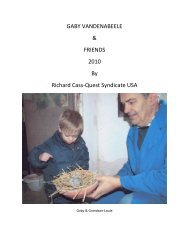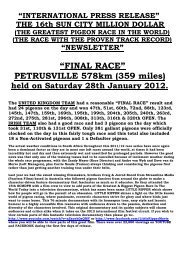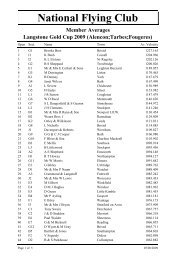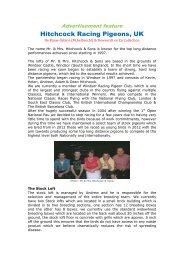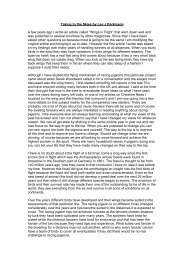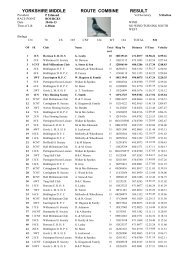Transporting Racing Pigeons - Elimar Pigeon Services
Transporting Racing Pigeons - Elimar Pigeon Services
Transporting Racing Pigeons - Elimar Pigeon Services
- No tags were found...
Create successful ePaper yourself
Turn your PDF publications into a flip-book with our unique Google optimized e-Paper software.
Monitoring thermal conditions during transport of racing pigeons on avehicle equipped with controlled ventilationThe vehicleA novel vehicle has been designed and constructed to ensure optimalconditions for pigeons while being transported to races. In particular, thevehicle addresses the specific requirements of the holding period immediatelyprior to release.The vehicle design is based on a twin axle step-frame semi-trailer. The basicframework comprises a solid floor, headboard, tailboard and roof. The sides ofthe vehicle operate as gull-wings to enable easy access to the cages forrelease of the birds. All the external surfaces, including the floor are insulatedto reduce solar heat gain. The internal structure of the vehicle comprises anumber of wire cages, to hold the pigeons, which fit into a main framework onthe vehicle. <strong><strong>Pigeon</strong>s</strong> are loaded into the wire cages then the cages loaded intothe vehicle. Overall vehicle height is 4m to comply with the requirement totravel in mainland Europe. Two vehicles have been built, one incorporates anattendants compartment that “replaces” the front stack of cages on either sideof the vehicle.On a typical vehicle carrying 5000 pigeons, there is a potential to produce atotal heat output (at 5 Watts per bird) of 25 kW (kilowatts). Studies with poultrysuggest that around half of this heat will be “lost” as latent heat (that is heatused in evaporating water from, for example, respired air). Failure to removethis heat (and moisture) will result in localised conditions within the containerthat are markedly different from the “external conditions”. These conditionsmay impose an additional “thermal load” on the pigeons, requiring them toexpend more effort in maintaining their “normal” body temperature.When a vehicle is moving, the resultant air movement around and within thevehicle will disperse some of the heat. However, when the vehicle isstationary, and especially on still days with little wind, the consequentventilation may be inadequate.The installation of fans on the vehicle ensures that there is adequate airmovement around the pigeons at all times – irrespective of vehicle movement.Fans and ventilation rateFans have been installed in the roof of the vehicle along the centre lineenabling air to be extracted from the central service corridor. This method hasbeen used, as the vehicle is relatively long. Air extraction at the ends wasconsidered but was likely to lead to significant non-uniformity producingregions of poor ventilation within the vehicle. Sidewall extraction was notpossible for operational requirements, as all the birds must be released in lessthan one minute.
The service corridor along the centre of the vehicle enabled roof extraction tobe effective. The presence of this corridor however also made end ventilationmore difficult to design, manufacture and operate, as variable sized side inletswould be required for uniform air distribution.The roof ventilation system is specifically designed for the stationary vehicle instill air, such as on a Ro-Ro ferry. This is likely to be the ‘worst case’ scenarioas the motion of the vehicle on the road will increase ventilation as will windon both the moving vehicle and when it is stationary.Theoretical calculations were used to determine the required ventilation ratefor the vehicles. Two sets of calculations were made, one allowing for theattendant’s cabin located at the front and occupying a 1.2m length. This cabinoccupies the space taken by two stacks of cages (total of 14 cages). The twocalculations were thus for a vehicle with 18 stacks – 154 cages, and for avehicle with 20 stacks – 168 cages.Within each calculation, two stocking densities were considered, namely 30birds per cage for short journeys and 26 birds per cage for long journeys.The calculations made the following assumptions:1. Full-length ventilation slots at the top edge of the release door of eachcage of 12mm.2. The side wall louvred inlets have an open area ratio of 70%.3. A heat production of 5 watts per bird has been used.4. The calculated air speed at the cage inlet assumes that air is not ableto enter the vehicle by other routes. In practice, it is not possible to‘seal’ the vehicle and some leakage occurs. Excessive leakage may bedetrimental to the uniformity of ventilation and needs to be avoided.5. The calculated air speed through the gull-wing sides assumes that allthe flow is through the louvres; in this case leakage is not likely todetract from the uniformity of ventilation.6. The derived air temperature lift, i.e. the difference in temperature of theoutlet air compared to the inlet air, is based on sensible heat gain only.In practice we have found that, with studies on poultry transportvehicles, around half the sensible heat will be transferred to latent heatof evaporation as there is water present in respired air and also inexcreta. Adequate ventilation will assist in keeping the litter dry and insuppressing ammonia production.7. The values of pressure drop are small which makes this designsensitive to external air movement caused by the motion of the vehicleor wind. In both cases ventilation is likely to increase but can beexpected to become non-uniform. The open sides to the cages permitairflow along the length of the vehicle that should help to mitigate theadverse effects of non-uniform ventilation.The calculations can be summarised as follows:18 stack vehicle (with attendant cabin) - 9 fans each producing 0.25 m 3 /s
20 stack vehicle - 10 fans each producing 0.25 m 3 /sair speed at cage inlet approximately 1 m/sair speed at louvre inlet approximately 0.5 m/sventilation rate in cages approximately 180 air changes per hourFan controlThe temperature within the roof space determines the number of fans thatoperate. A temperature sensor is mounted in the roof area on the centre line.A simple control strategy ensures that as the temperature rises, more fans areautomatically switched on.The system starts with two fans running then when the temperature reaches15°C a further two fans are switched on. At 19°C, there are 6 fans running, at24°C there are 8 fans running and at 28°C all the fans are operating.Field evaluationThe performance of the ventilation system, in terms of the temperatures andwater vapour densities within the vehicle, has been assessed during thetransport of pigeons in Summer 2007 on journeys to Fougeres and Tarbes.Measurements were made using Gemini TinyTag data loggers that recordtemperature and relative humidity at 10 minute intervals. Eight data loggerswere installed on each trailer at similar specific locations.External to the trailer:2 loggers to record ambient conditions – located near the trailer “landing legs”
Within the central trailer passageway, attached to the structure on the insideface of the cages:2 loggers to record conditions on the 3 rd stack from the front (2 nd stack on thetrailer with the attendant cabin). One logger was at the level of the third row ofcages down from the top and the other at the level of the seventh row ofcages down from the top.2 loggers to record conditions on the 6 th stack from the front (5 th stack on thetrailer with the attendant cabin). Vertical placement as described above.2 loggers to record conditions on the 9 th stack from the front (8 th stack on thetrailer with the attendant cabin). Vertical placement as described above.The data loggers record temperature and relative humidity but relativehumidity is itself dependent upon air temperature and relates to the relativecapacity of the air to hold water vapour. Consequently, all the data for relativehumidity have been converted to water vapour density that is an absolutemeasure of the water content of the air.FougeresBoth trailers travelled to Fougeres in May, arriving at the release site at11:30am on 18 th May then standing until the release time of 07:30am on 19 thMay.Water ingress confounded a full data set from either of the ambient loggers onthe 9 stack trailer (with attendant cabin) but the remaining data had goodagreement with data from the corresponding loggers on the 10 stack trailer.
Both trailers travelled together so it is reasonable, and for clarity, to presentonly the 10 stack ambient data.The variations in temperature and vapour density during the journey toFougeres and while awaiting release are shown below. These plots presentthe ambient conditions and the average conditions within each trailer basedon “pooling” all the data for the respective trailer (i.e the average for all 6loggers in each trailer).Fougeres30.028.026.024.0Ambient (10)All cages (10)All cages (9)Temperature (°C)22.020.018.016.014.012.0StandingRelease10.021:00 01:00 05:00 09:00 13:00 17:00 21:00 01:00 05:00TimeFor both temperature and vapour density there is good agreement betweenthe ambient conditions and those within the vehicle.Fougeres18.017.0Vapour density (g/m 3 )16.015.014.013.012.011.0Ambient (10)All cages (10)All cages (9)10.09.0StandingRelease8.021:00 01:00 05:00 09:00 13:00 17:00 21:00 01:00 05:00TimeOf particular interest is the 20-hour standing period pre-release where it mightbe expected that on a “standard” trailer, conditions within the vehicle mighthave become thermally more demanding for the pigeons.The recorded data also allow a comparison of the different locations to checkfor uniformity of conditions. A comparison has been made between front,middle and rear stacks of cages, and between upper and lower levels ofcages.
The data plots below are for the 10 stack trailer (and the 9 stack trailer issimilar) and present the variation in temperature during the journey, as before,but with the additional data for the different locations.Fougeres - 10 stack trailerTemperature (°C)30.028.026.024.022.020.018.0Ambient (10)All cages (10)Front (10)Middle (10)Rear (10)Upper (10)Lower (10)16.014.012.0StandingRelease10.021:00 01:00 05:00 09:00 13:00 17:00 21:00 01:00 05:00TimeThere are similar variations for changes in water vapour density.Fougeres - 10 stack trailerVapour density (g/m 3 )16.015.014.013.012.011.0Ambient (10)All cages (10)Front (10)Middle (10)Rear (10)Upper (10)Lower (10)10.09.0StandingReleaseThe data demonstrate the uniform nature of the thermal environmentthroughout the vehicle and the maintenance of acceptable conditions thatfollow closely the changes in ambient conditions.Tarbes8.021:00 01:00 05:00 09:00 13:00 17:00 21:00 01:00 05:00Only one trailer (the 9 stack with attendant cabin) travelled to Tarbes in June2007. The early departure of the trailer meant that data recording did not startuntil the vehicle was about to disembark from the ferry.Data loggers were again placed in the same positions as for the Fougeresjourney.Of interest on this journey was the extended holding period of 46.5 hours priorto the release of the pigeons. The “pooled” data for temperature and watervapour density have been plotted below.Time
Tarbes Grand National Race30.028.026.0AmbientAll cagesRelease24.0Temperature (°C)22.020.018.016.014.012.0Standing10.007:00 19:00 07:00 19:00 07:00 19:00 07:00TimeTemperatures within the vehicle follow the ambient diurnal trends but maintainthe overall temperature to within 3°C of outside. The water vapour density ismaintained similarly.Tarbes Grand National Race16.015.0AmbientAll cagesRelease14.0Vapour density (g/m 3 )13.012.011.010.09.0Standing8.007:00 19:00 07:00 19:00 07:00 19:00 07:00TimeAs with the journeys to Fougeres, inspection of the locations within the vehicleconfirms a uniform thermal environment throughout the journey including theextended stationary period prior to release.Tarbes Grand National Race30.028.026.024.0AmbientFrontRearLowerAll cagesMiddleUpperReleaseTemperature (°C)22.020.018.016.014.012.0Standing10.007:00 19:00 07:00 19:00 07:00 19:00 07:00TimeThe “spike” in the temperature and vapour density trace for the rear locationmay be an artefact associated with the opening of the rear door of the trailerduring the standing period.
It is difficult without a full record of events to give a definitive resolution toTarbes Grand National Race16.0AmbientAll cages15.0FrontRearMiddleUpperRelease14.0LowerVapour density (g/m 3 )13.012.011.010.09.0Standingsuch events but such are the challenges of making measurements under fullycommercial conditions.Concluding remarks8.007:00 19:00 07:00 19:00 07:00 19:00 07:00TimeThe field evaluation of the new pigeon transport vehicle suggests that it isworking as designed. The primary concern has always been the potentiallydetrimental effects of hot weather. Features such as the insulation haveensured that external heat sources are kept to a minimum.In addition to the direct heat and moisture loads from the birds per se, otherfactors have been taken into consideration. Additional heat from solarradiation has been minimised by the use of insulation in the vehicleconstruction. The requirement to provide watering for the birds during thejourney has been another potential source of concern. Any water that isspilled will evaporate into the airspace within the trailer thus presenting thepigeons with a greater thermal challenge.The provision of fans to remove both heat AND moisture, from whateversource, has been shown to optimise conditions for the pigeons uniformlythroughout the vehicle especially during standing periods prior to release.Peter Kettlewell, ADASRoger Hoxey, Birmingham UniversityOctober 2007



